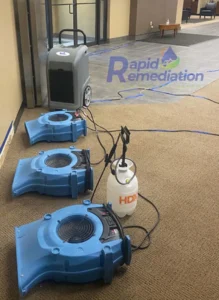Creating a water damage emergency response plan? Let us help you!
Not sure if you need one? You do,
CLICK HERE to read PART 1 and find out why!
4 steps to create a Water Damage Emergency Response Plan:
- Assemble a Response Team
Identify key personnel responsible for executing the emergency response plan. This team may include facility managers, security personnel, maintenance staff, and external contractors such as
Rapid Remediation. Our technicians are
IICRC certified and will respond day or night.
- Develop Clear Procedures
Outline step-by-step procedures for responding to water damage incidents. Clearly define roles and responsibilities, including who to contact, how to shut off the water sources, and how to prioritize actions in different scenarios. Contacting professionals ASAP is critical to save your business assets and operations!
- Invest in Preventative Measures
Implement preventive measures such as routine inspections, maintenance of plumbing systems, and the installation of water detection systems. These measures can help identify potential issues before they escalate.
- Establish Communication Protocols
Establish clean communication protocols, both internally and externally. Ensure that all relevant personnel are aware of the emergency response plan and know how to communicate effectively during a crisis.
- Host Trainings and Drills
Regularly train your response team and conduct emergency drills to ensure everyone is familiar with their roles and can respond efficiently in high-pressure situations. The
Center for Disease Control and Prevention (CDC) site has excellent resources for planning, training and responding!

The Environmental Protection Agency has a great template for developing a
wastewater and/or
drinking water systems emergency response plan.
A water damage emergency response plan is an essential component of protecting your commercial or residential building investment. It not only safeguards your property and assets but also ensures business continuity and compliance with legal requirements. By taking proactive steps to create and implement a comprehensive plan, you can minimize the impact of water damage incidents and demonstrate your commitment to the long-term resilience of your commercial or residential property. Do not let your lack of preparation risk the integrity of your building’s structural foundation or operation of your business.
 The Environmental Protection Agency has a great template for developing a wastewater and/or drinking water systems emergency response plan.
A water damage emergency response plan is an essential component of protecting your commercial or residential building investment. It not only safeguards your property and assets but also ensures business continuity and compliance with legal requirements. By taking proactive steps to create and implement a comprehensive plan, you can minimize the impact of water damage incidents and demonstrate your commitment to the long-term resilience of your commercial or residential property. Do not let your lack of preparation risk the integrity of your building’s structural foundation or operation of your business.
The Environmental Protection Agency has a great template for developing a wastewater and/or drinking water systems emergency response plan.
A water damage emergency response plan is an essential component of protecting your commercial or residential building investment. It not only safeguards your property and assets but also ensures business continuity and compliance with legal requirements. By taking proactive steps to create and implement a comprehensive plan, you can minimize the impact of water damage incidents and demonstrate your commitment to the long-term resilience of your commercial or residential property. Do not let your lack of preparation risk the integrity of your building’s structural foundation or operation of your business.